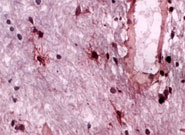The team found that mice designed to express a large amount of the neuropeptide ‘galanin’ were completely resistant to the MS-like disease, experimental autoimmune encephalomyelitis (EAE). Transgenic mice that contained no galanin at all developed a more severe form of the disease.
Subsequent tests on human brain tissue affected by MS showed galanin to be specifically upregulated in MS lesions and shadow plaques, which are often seen in acute MS.
These important results suggest that galanin could have future therapeutic implications for multiple sclerosis.
Professor David Wynick who initiated the research and works on the function of galanin in the relief of neuropathic pain said: “It has been known for some time that galanin plays a protective role in both the central and peripheral nerve systems; when a nerve is injured levels of galanin increase dramatically in an attempt to limit cell death.
“When I heard that someone had shown galanin was upregulated in Alzheimer’s disease, I decided to investigate if it was also important in MS. To do this I formed a collaboration with Professors David Wraith and Neil Scolding who both work on MS.”
Wraith, who is working on a vaccine for the treatment of multiple sclerosis, investigated the MS-like disease in the various galanin transgenic mice developed in the Wynick lab.
Professor Wraith said: “The results were really remarkable: rarely do you see such a dramatic effect as this. Mice with high levels of galanin just didn’t develop any signs of disease. We have a lot more to do to figure out how this works but the results are extremely promising.”
Wynick then turned to Professor Neil Scolding who studies the use of stem cells in the treatment of multiple sclerosis. Scolding provided human brain tissue affected by multiple sclerosis and, as the team predicted, galanin was also shown to be upregulated in this brain tissue.
Professor Scolding said: “The results of this research are very significant and provide new insights into how the disease might be treated”.
Although these early results are very encouraging there is still a large amount of work to be done before a drug can be developed to help MS sufferers, and it will be at least 10 years before such a drug is on the market.
Professor Wynick’s spin-out company, NeuroTargets, owns the intellectual property relating to this work and it will be seeking the substantial funding needed to advance these findings.
